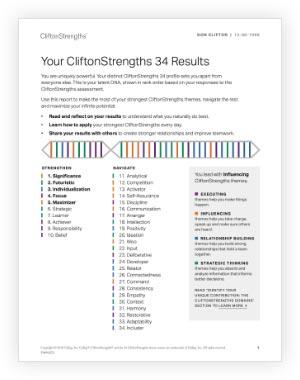Story Highlights
- Using strengths as a common language improves engagement and performance
- To change a culture, all employees need the opportunity to learn their strengths
- When everyone "speaks strengths," work gets done more efficiently
As leaders grapple with how to build cultures of inclusion, using a common language based on strengths can be an effective tool.
Pivoting from divisive factors to 34 ways to describe what people naturally do best (in 33.4 million varieties of top five theme combinations) can help everyone get at the heart of what makes humans alike: the way we think, feel and behave.
Leaders can choose to have pockets of their teams explore their talents using a strengths-based approach like CliftonStrengths -- but to change a culture, it can't be that just a few experience it. It needs to be baked in, and everyone needs to take part.
Employees who agree that their organization "is committed to building the strengths of each associate" are also much likelier to agree that:
- their organization's mission -- and therefore their job -- is important
- they are supported in their development efforts
- their opinions count
- they have an opportunity to learn and grow at work
- they can do what they do best every day
- someone at work cares about them
- they receive helpful feedback on how they are doing
Employees who know and use their strengths are six times as likely to be engaged at work, nearly 8% more productive in their role and much less likely to leave their company.
Business leaders who invest in building cultures where people are positioned to do what they do best every day see up to 19% increased sales, 29% increased profits, 59% fewer safety incidents and 72% lower turnover (in high-turnover organizations).
These outcomes sound pretty good -- but taking the step from knowing about a strengths-based culture to leading one requires a shift in how decisions are made. The "way things happen" in the workplace must be underpinned with an appreciation for what makes each employee unique. That starts with a baseline expectation that each person has an opportunity to discover what they do best.
Leaders can set the expectation for every employee to learn and use a common language about strengths.
In theory, it is possible to get to know what others do best through observation and interaction over time.
But when leaders have everyone take the CliftonStrengths assessment, they speed things up by adding a common language for everyone to use to describe each other's potential right from the start.
An approach like this is designed to underpin a strengths-based culture by improving communication and opportunities for development all throughout the employee life cycle.
When everyone uses a common language to describe what they naturally do best -- from the very beginning, starting when someone joins the organization, meets their team, partners with or collaborates with someone new, or is mentored by someone -- everyone speaks in "strengths."
In this way, when leaders expect everyone to learn about and apply their CliftonStrengths, they fuel the creation of an inclusive, collaborative culture. Everyone knows each person's potential superpowers right from the start.
Leaders should also expect constructive communication and development using a strengths-based approach.
Without a real commitment to ingraining the language of strengths in the culture, everyone loses precious time in the potentially messy process of figuring out how best to work together.
Team members can even get their wires crossed with each other -- meaning they fail to understand one another while trying to figure it out. That happens when people don't understand the motivations of those around them.
For example, someone who likes to make fast decisions may grow irritated when a partner prefers to move more slowly (and vice versa). What can be less obvious without an understanding of strengths is that the slow-mover is mitigating for potential barriers while the fast-mover is pushing for the action that makes things happen.
Rather than having a conversation about their different approaches, where they can each name their strengths and the motivation that those strengths create for them to act in that way, they end up feeling it out and naturally experience friction along the way. This can end up as fodder for more frustration rather than productive outcomes.
Without a real commitment to ingraining the language of strengths in the culture, everyone loses precious time in the potentially messy process of figuring out how best to work together.
It's even worse when managers repeatedly assign work to employees in areas that don't fit them well or align with their natural talents. Each move the employee makes on behalf of the organization can negatively affect their own engagement and the outcomes they aim to deliver for customers.
When managers "speak strengths," though, the projects they assign can boost both growth for the individual and ultimately performance outcomes for the company.
And when everyone speaks strengths when starting projects together, they might choose partners who complement their work style. Or they might just acknowledge their differences upfront and stay respectfully aware of them as they navigate the completion of the project together.
Focusing on strengths doesn't mean forgetting about weaknesses or overlooking poor performance. But learning the language of strengths enables discussion about barriers that may exist because of a misalignment of talent -- where coaching and support are needed to develop an area of strength, or where there's a void to fill via partnerships, processes or shifts in work.
In cultures that are truly strengths-based, people working together are able to move past annoyances and miscommunications to acceptance, appreciation and ultimately admiration for the differences that help them to achieve results together.
The "way things happen" in the workplace must be underpinned with an appreciation for what makes each employee unique.
As the late Peter Drucker said, "Culture eats strategy for breakfast."
An organizational culture where people work outside their personal strengths zone, day after day, does very little for business performance.
On the other hand, the performance outcomes of strengths-based cultures are clear.
With a focus on what employees do best, leaders who prioritize strengths development provide a common language for people to discuss how they can collaborate effectively -- creating an inclusive culture where teams can build on those proven performance outcomes and generate organic business growth.
Not sure where to start? Let us help.
- Explore our free online guide for creating a strengths-based company culture, or listen to our webcast How to Create a Strengths-Based Culture in Your Organization.
- Learn why over 23 million people are using their CliftonStrengths to do their best work and live their best lives.
- Partner with us to make your aspirational culture a reality.
Editor's Note: A previously published version of this article stated that employees who know and use their strengths are "nearly eight times more productive in their role." This has been corrected to read "nearly 8% more productive in their role."




